General Flowchart
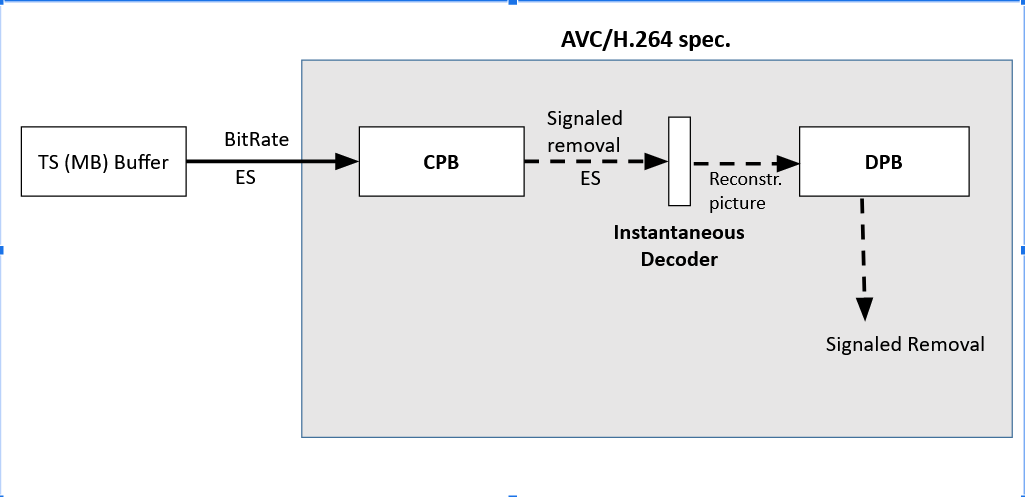
Details
- Frames are removed from CPB instantaneously and decoded instantaneously and put onto DPB instantaneously. In other words a frame moves from CPB to DPB via Decoder in 0 seconds. Therefore HRD model is called Hypothetical.
- CBP Size (in bits) is specified in VUI (sub-section of SPS) via cpb_size_value_minus1 and cpb_size_scale as
CpbSize = ( cpb_size_value_minus1+ 1 ) <<(4+ cpb_size_scale)
- The bitrate (bits per second) is specified in VUI via bit_rate_value_minus1 and bit_rate_scale as
BitRate = (bit_rate_value_minus1+1)<<(bit_rate_scale+6)
- DPB Size granularity is in units of frames and specified in VUI by max_dec_frame_buffering, if this parameter not present derived from Table A-1 of the spec. according to level.
- Removal Time from DPB is specified in picture timing SEI by dpb_output_delay, this parameter is signaled for each picture. Frame is removed from DPB instantaneously.
- Removal Time from CPB is specified in picture timing SEI by cpb_removal_delay. The cpb_removal_delay denotes the frame removal time (in units of clock ticks, details are present later) from the last buffering period SEI. This parameter is signaled for each picture and encoded frame is removed from CPB instantaneously. Thus, cpb_removal_delay is monotonically increasing along frames until next buffering_period SEI message encountered. The number of bits allocated for cpb_removal_delay is specified by the VUI parameter cpb_removal_delay_length. You should choice the magnitude of cpb_removal_delay_length such that no wrap-around occur within the maximal buffering-period interval. For example, if you specify cpb_removal_delay_length=8 bits and the frame duration is 2 clock ticks, then the number of frames between two buffering period SEIs must be smaller 512.
- TS buffer is not specified in H.264/AVC. However, it’s specified in Blu-Ray spec. (named as MB1 or Multiplexor buffer) and it has a constant size of 40000 bytes (Table 8-3 of Blu-Ray spec).
- The input rate to TS buffer is leak rate (the rate is specified in Table 8-2 of Blu-Ray spec). For level 4.1 the input rate is 1.2*40*10^6 bits/sec.
Some definitions for following parts:
- Ta(n) – the time when the first bit of the picture #n enters the CPB, called the arrival time of picture #n.
- Tf(n) – the time when the last bit of the picture #n enters the CPB, called the final arrival time of the picture #n. Tf(n) is equal to Ta(n)+PictureSize/BitRate.
- Tr(n) – the time when the picture #n is removed from the CPB, called the removal time.
When Frames Removed from CPB?
- Frame is removed from CPB according to cpb_removal_delay (signaled in the pic_timing SEI associated with the given frame).
- cpb_removal_delay is specified in units of clock ticks from arrival of the last buffering_period SEI
- Clock Tick (Tc) is derived from num_units_in_tick and time_scale (signaled in VUI) as
Tc = num_units_in_tick /time_scale
Tc also specifies the duration of field in seconds, hence the duration of frame is 2 x Tc seconds.
- To convert cpb_removal_delay to seconds use the following:
cpb_removal_delay * Tc
- The removal time Tr( n ) of the frame #n from CPB is specified as follows:
Tr( n ) = Tr( last buffering period ) + tc * cpb_removal_delay( n )
- Usually the buffering period SEI is signaled at the start of GOP (not necessarily each GOP).
When the Very First Frame Removed from CPB?
Initial removal time ( or removal time of the very first frame) in seconds is specified by initial_cpb_removal_delay/90000, where initial_cpb_removal_delay is present as a parameter in buffering_period SEI.
When Data starts to Flow to TS buffer and Restrictions?
- The start time is specified by the first PCR, at this time data commence to flow to TS buffer and immediately “drain” to CPB with the predefined rate BitRate.
- Only after initial_cpb_removal_delay/90000 seconds Decoder starts to remove data from CPB. Thus, decoding delay is equal to initial_cpb_removal_delay/90000 .
- Blue-Ray limits maximal delay to 1 sec., i.e. initial_cpb_removal_delay < 90000. The maximal delay of 1 second puts restrictions on CPB size and BitRate, i.e. if we divide a declared CPB buffer size (CpbSize) with a declared bit-rate (BitRate) then the result must be less or equal to 1, if not, the buffer size is need to be reduced or BitRate is need to be increased.
VBR and CBR Modes
- CBR – signaled by cbr_flag=1 in VUI.
In this mode data from TS buffer flows with a constant rate BitRate, i.e. the tap between TS and CPB is always open. Hence, Ta(n) = Tf(n-1).
- VBR – signaled by cbr_flag=0 in VUI.
In this mode the tap between TS and CPB can be closed temporarily (to prevent CPB overflows), however when the tap is open data flows with constant rate BitRate. Hence, Ta(n) ≥ Tf(n-1).
Note: in both mode bit-rate is specified as
BitRate = (bit_rate_value_minus1+1)<<(bit_rate_scale+6)
CBR Mode Example
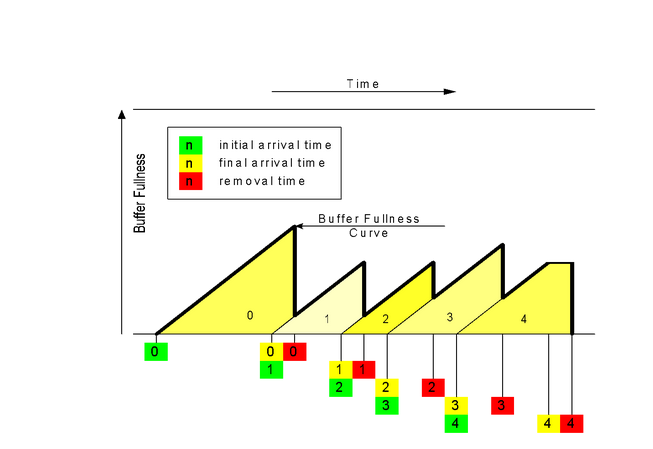
VBR Mode Example
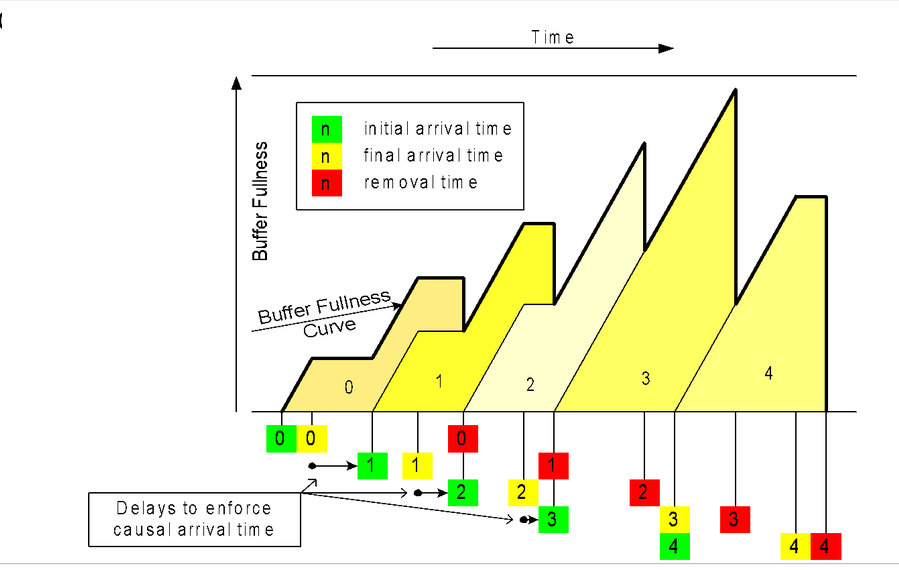
How Arrival Time Derived in VBR mode?
Unlike CBR mode, Ta(n) > Tf(n-1). In other words in the period of [Ta(n) – Tf(n-1)] seconds the tap is closed.
Before let’s specify what is Te(n) – earliest time for the picture #n to enter:
a) For non-IDR frame
Te(n) = Tc*cpb_removal_delay(n) + Tr(last idr) –(initial_cpb_removal_delay+initial_cpb_removal_delay_offset)/90000
where Tc = num_units_in_tick /time_scale
b) For IDR frame
Te(n) = Tc*cpb_removal_delay(n) + Tr(last idr) – initial_cpb_removal_delay/90000
The arrival time of frame #n is
Ta( n ) = Max( Tf( n − 1 ), Te( n ) )
How Prevent Violations
To prevent underflow of TS buffer in VBR it’s necessary to close the tap, in other words to increase Te(n).
We can decrease cpb_removal_delay, this action would cause the tap to be closed more frequently.
However, by closing the tap we increase a risk to underflow CPB.

23+ years’ programming and theoretical experience in the computer science fields such as video compression, media streaming and artificial intelligence (co-author of several papers and patents).
the author is looking for new job, my resume


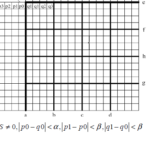
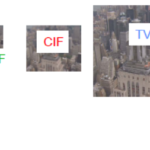
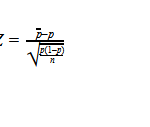

There is noticeably a bunch to realize about this. I assume you made various nice points in features also.
Hmm is anyone else encountering problems with the pictures on this blog loading? I’m trying to figure out if its a problem on my end or if it’s the blog. Any suggestions would be greatly appreciated.
Hi, i believe that i saw you visited my web site thus i came to “go back the desire”.I’m trying to in finding things to improve my website!I suppose its adequate to use a few of your concepts!!
pls. correspond with our web-designer Ivan Lukin vanyalukin007@gmail.com
Really nice layout and excellent content material, practically nothing else we need : D.
Simply want to say your article is as astonishing. The clarity in your post is just cool and i could assume you are an expert on this subject. Well with your permission allow me to grab your feed to keep up to date with forthcoming post. Thanks a million and please keep up the gratifying work.
You have brought up a very superb details , regards for the post.
It’s really a cool and useful piece of information. I am happy that you simply shared this useful information with us. Please stay us informed like this. Thanks for sharing.
Thanks for the auspicious writeup. It in truth used to be a enjoyment account it. Glance complex to far added agreeable from you! By the way, how can we communicate?
slavah264@gmail.com
I’ve read some excellent stuff here. Certainly value bookmarking for revisiting. I surprise how much effort you set to create this sort of great informative site.
Good website! I really love how it is simple on my eyes and the data are well written. I am wondering how I might be notified when a new post has been made. I’ve subscribed to your RSS which must do the trick! Have a nice day!
Very excellent visual appeal on this web site, I’d value it 10 10.
I see something really special in this internet site.
Magnificent beat ! I wish to apprentice whilst you amend your web site, how can i subscribe for a blog web site? The account aided me a applicable deal. I were tiny bit acquainted of this your broadcast offered brilliant transparent idea
Some genuinely nice and useful info on this web site, likewise I think the style and design has got wonderful features.
you have a great blog here! would you like to make some invite posts on my blog?
I truly value your piece of work, Great post.
I am impressed with this website , really I am a fan.